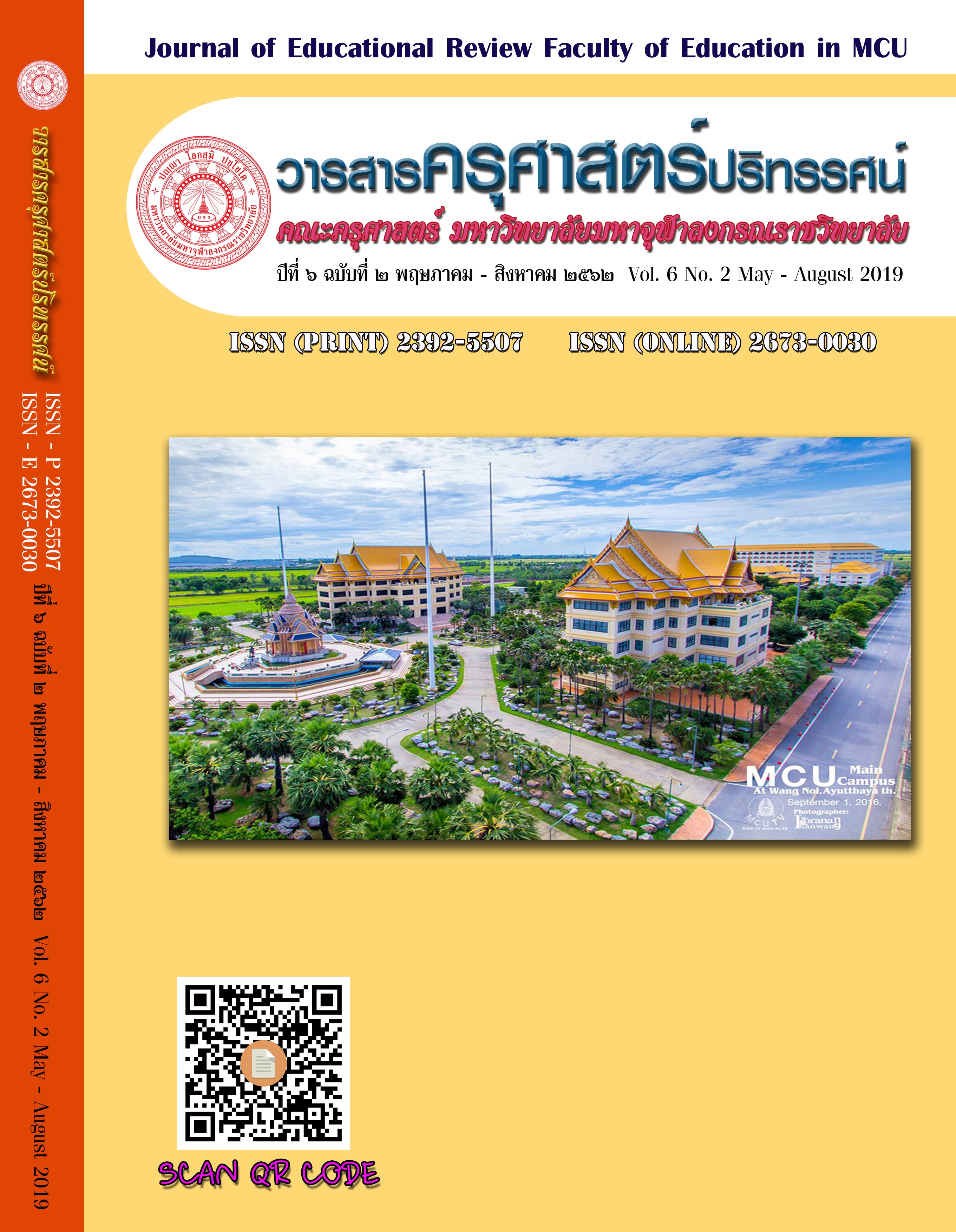An Analytical Study of Vipassana Teaching of Phrakrubhavanavisuddhaphorn
Main Article Content
Abstract
The research entitled “An Analytical Study of Vipassana Teaching of Phrakrubhavanavisuddhaphorn” There are three objectives: 1) to study the Vipassana kammaṭṭhana teaching in Theravada Buddhist scriptures, 2) to study the Vipassana kammaṭṭhana practice of Phrakrubhavanavisuddhaphorn, and 3) to analyze the Vipassana kammaṭṭhana teaching of Phrakrubhavanavisuddhaphorn. This research based on qualitative research method that data collected from documents and in-depth interview.
The result of the study found that the Vipassana Kammaṭṭhana teaching in Theravada Buddhist scriptures is a taught how to consider things in the human body by four principles: kāyanupassanā satipaṭṭhāna, vedanānupassanā satipaṭṭhāna, cittānupassanā satipaṭṭhāna, and dhammāsnupassanā satipaṭṭhāna. The persons who practice according to these principles can attend enlightenment as soonest in seven days and latest in seven years. The sense bases of Vipassana are five khandha, twelve āyatana, eighteen dhātu, twenty-two indriya, four sacca, and twelve paṭiccasamuppāda.
Phrakrubhavanavisuddhaphorn (savat amaro) has learned rūpa and nāma kammaṭṭhana practice since 1971 from Phrakrubhavanavisuddhinan (Phramahaphan Silasuddho) and pilgrimage walk with Phrabuddhacan (Aj āsabho) from 1973 to 1988. In 1988 he lived at Wat Neramittavipassana. In 1997 he became the meditation master of Neramittavipassana that focused on teaching the Dhamma principles related to self-independence, self-treatment, and self-awareness beyond other things. The practitioners have changed their behaviors, mindfulness, wisdom, intelligence, and patient.
The Vipassanakammaṭṭhana teaching of Phrakrubhavanavisuddhaphorn is to concentrate on rūpa and nāma form and name as sense bases by learning in one-self both the body and the mind. Meditation in four main postures: standing, walking, sitting, and laying, and sub-bodily movements to see the rising and falling, concentrate on vedanā, ciita, and dhamma that occurred and see the rising and falling as anicca, dukkha, and anattā. The teaching of rūpa and nāma model has relation with the four satipaṭṭhāna.
Article Details
ทัศนะและความคิดเห็นที่ปรากฏในบทความในวารสารฉบับนี้ถือเป็นความรับผิดชอบของผู้เขียนบทความนั้นเพียงผู้เดียว และไม่ถือเป็นทัศนะและความรับผิดชอบของกองบรรณาธิการ
กองบรรณาธิการขอสงวนสิทธิ์ในการคัดเลือกบทความลงตีพิมพ์และจะแจ้งให้เจ้าของบทความทราบหลังจากผู้ประเมินบทความตรวจอ่านบทความแล้ว
ต้นฉบับที่ได้รับการตีพิมพ์ในวารสารครุศาสตร์ปริทรรศน์ คณะครุศาสตร์ มหาวิทยาลัยมหาจุฬาลงกรณราชวิทยาลัย ถือเป็นกรรมสิทธิ์ของคณะครุศาสตร์ มหาวิทยาลัยมหาจุฬาลงกรณราชวิทยาลัย ห้ามนำข้อความทั้งหมดหรือบางส่วนไปพิมพ์ซ้ำ เว้นเสียแต่ว่าจะได้รับอนุญาตจากมหาวิทยาลัยฯ เป็นลายลักษณ์อักษร
References
พระภัททันตะ อาสภมหาเถระธัมมาจริยะอัคคมหากัมมัฏฐานาจริยะ. (๒๕๒๖). วิปัสสนาทีปนีฎีกา. กรุงเทพมหานคร: พีแอนด์โฟ.
พระมหาบุญเพ็ง วรธมฺโม. (๒๕๕๑). วิปัสสนากรรมฐานรูป-นาม. กรุงเทพมหานคร : รุ่งแสงธุรกิจการพิมพ์.
________. (๒๕๕๔). คู่มือสวดมนต์วัดเนรมิตวิปัสสนาพิมพ์ครั้งที่ ๖. เลย: รุ่งแสงธุรกิจการพิมพ์.
พระสังฆราชเมธังกร. (๒๕๒๙). โลกทีปกสาร. กรุงเทพมหานคร: สหประชาพานิชย์.
พระสัทธรรมโฆษเถระ. (๒๕๒๙). โลกบัญญัติ. กรุงเทพมหานคร: โรงพิมพ์อักษรไทย.
มหาจุฬาลงกรณราชวิทยาลัย. (๒๕๓๙). พระไตรปิฎกภาษาไทย ฉบับมหาจุฬาลงกรณราชวิทยาลัย.กรุงเทพมหานคร: โรงพิมพ์มหาจุฬาลงกรณราชวิทยาลัย.
________. (๒๕๕๖). อรรถกถาภาษาไทย ฉบับมหาจุฬาลงกรณราชวิทยาลัย. กรุงเทพมหานคร: โรงพิมพ์มหาจุฬาลงกรณราชวิทยาลัย.


